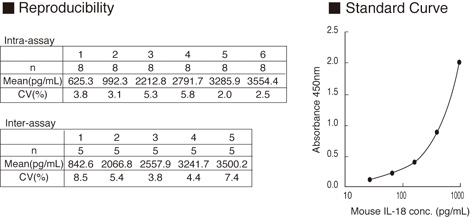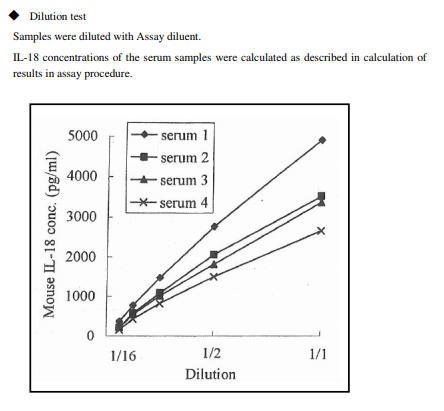Mouse IL-18 ELISA Kit
| Code | Size | Price |
|---|
| MBL-7625 | 96 Wells | £603.00 |
Quantity:
Prices exclude any Taxes / VAT
Overview
Host Type: Mouse
Regulatory Status: RUO
Application: Enzyme-Linked Immunosorbent Assay (ELISA)
Shipping:
4°C
Storage:
-20°C
Images
Documents
Further Information
Alternative Names:
interleukin 18 (interferon-γ-inducing factor)
Background:
Interleukin 18 (IL-18) is an 18 kDa cytokine which is identified as a costimulatory factor for production of interferon-γ (IFN-γ) in response to toxic shock. It shares functional similarities with IL-12. IL-18 is synthesized as a precursor 24 kDa molecule without a signal peptide and must be cleaved to produce an active molecule. IL-1β converting enzyme (ICE, caspase-1) cleaves pro-IL-18 at aspartic acid in the P1 position, producing the mature, bioactive peptide that is readily released from the cells. It has been reported that IL-18 is produced from dendritic cells, activated macrophages, Kupffer cells, keratinocytes, intestinal epithelial cells, osteoblasts, adrenal cortex cells and murine diencephalons.
IFN-? is produced by activated T and NK cells and plays critical roles in the defense against microbial pathogens. IFN-γ activates macrophages, enhances NK activity and B cell maturation, proliferation and Ig secretion, induces MHC class I and II antigens expression, and inhibits osteoclast activation.
IL-18 acts on T helper 1-type (Th1) cells, and in combination with IL-12 strongly induces production of IFN-γ by these cells. Pleiotropic effects of IL-18 have also been reported, including enhancement production of IFN-γ and GM-CSF in peripheral blood mononuclear cells, production of Th1 cytokines, IL-2, GM-CSF and IFN-γ in T cells, enhancement of Fas ligand expression by Th1 cells.
The ?Human IL-18 ELISA Kit? is a useful reagent for specifically measuring human IL-18 with high sensitivity by ELISA.
This Kit does not detect 1 ng/mL of various cytokines, such as human IFN-α, IFN-γ, IL-1β, IL-4, IL-5, IL-6, IL-10, IL-12, GM-CSF and murine IL-18. The results were all bellow the detection limit of 12.5 pg/mL.
Description:
The Mouse IL-18 ELISA kit measures Mouse IL-18 by sandwich ELISA. The assay uses two
monoclonal antibodies against two different epitopes of Mouse IL-18.
In the wells coated with anti-Mouse IL-18 monoclonal antibody, samples to be measured or
standards are incubated. After washing, a peroxidase conjugated anti-Mouse IL-18 monoclonal
antibody is added into the microwell and incubated. After another washing, the peroxidase
substrate is mixed with the chromogen and allowed to incubate for an additional period of time.
An acid solution is then added to each well to terminate the enzyme reaction and to stabilize the
developed color. The optical density (O.D.) of each well is then measured at 450 nm using a
microplate reader. The concentration of Mouse IL-18 is calibrated from a dose response curve
based on reference standards.
Gene IDs:
Human: 3606 Mouse: 16173
Kit Components:
Microwell strips coated with anti-Mouse IL-18 antibody 8-well strip x 12 strips
Mouse IL-18 calibrator (Lyophilized) 2 vials
Conjugate reagent (Peroxidase conjugate anti-mouse IL-18
monoclonal antibody) (x101)
0.2 ml x 1 vial
Conjugate diluent (ready to use) 24 ml x1 vial
Assay diluent (ready to use) 30 ml x 1 vial
Washing buffer (powder) 3 packages
Substrate reagent (TMB/H2O2) (ready to use) 15 ml x 1 vial
Stop solution (2N H2SO4) (ready to use) (irritant) 18 ml x1 vial
Target:
IL-18
References
1). Anthony DA, et al., J Immunol, 185, 1794 (2010)
2). Banerjee S, et al., J Biol Chem, 283, 31371 (2008)
3). Broz P, et al., J Exp Med, 207, 1745 (2010)
4). Chen GY, et al., J Immunol, 186, 7187 (2011)
5). Costa A, et al., J Immunol, 188, 1953 (2012)
6). Gurung P, et al., J Biol Chem, 287, 34474 (2012)
7). Habu Y, et al., J Immunol, 166, 5439 (2001)
8). Hitzler I, et al., J Immunol, 188, 3594 (2012)
9). Hoshino T, et al., Am J Respir Cell Mol Biol, 41, 661 (2009)
10). Hoshino T, et al., Am J Respir Crit Care Med, 176, 49 (2007)
11). Hoshino T, et al., J Immunol, 166, 7014 (2001)
12). Humann J, et al., J Immunol, 184, 5172 (2010)
13). Ino Y, et al., Clin Cancer Res, 12, 643 (2006)
14). Ito H, et al., Int Immunol, 18, 1253 (2006)
15). Kim J, et al., Mol Biol Cell, 19, 433 (2008)
16). Kimura K, et al., J Leukoc Biol, 89, 433 (2011)
17). Konishi H, et al., PNAS, 99, 11340 (2002)
18). Kuranaga N, et al., J Infect Dis, 194, 993 (2006)
19). Kuroda-Morimoto M, et al., Int Immunol, 22, 561 (2010)
20). Li H, et al., J Immunol, 183, 1528 (2009)
21). Liu Z, et al., J Biol Chem, 287, 16955 (2012)
22). Mattarollo SR, et al., Blood, 120, 3019 (2012)
23). McPhee JB, et al., Infect Immun, 78, 3529 (2010)
24). Meldrum KK, et al., J Biol Chem, 287, 40391 (2012)
25). Nagarajan UM, et al., J Immunol, 188, 2866 (2012)
26). Nakano H, et al., Int Immunol, 15, 611 (2003)
27). Neumann D, et al., Int Immunol, 18, 1779 (2006)
28). Paget C, et al., J Immunol, 188, 3928 (2012)
29). Qiao H, et al., J Leukoc Biol, 81, 1012 (2007)
30). Reading PC, et al., J Immunol, 179, 3214 (2007)
31). Rodriguez-Galan MC, et al., J Immunol, 183, 740 (2009)
32). Sasaki Y, et al., J Exp Med, 202, 607 (2005)
33). Seki E, et al., J Immunol, 166, 2651 (2001)
34). Shirota H, et al., J Immunol, 174, 4579 (2005)
35). Srinivasan G, et al., J Immunol, 189, 1911 (2012)
36). Takahashi HK, et al., Mol Pharmacol, 70, 450 (2006)
37). Terada M, et al., PNAS, 103, 8816 (2006)
38). Tsai PY, et al., Am J Physiol Renal Physiol, 301, F751 (2011)
39). Wiersinga WJ, et al., Infect Immun, 75, 3739 (2007)
40). Yajima T, et al., Infect Immun, 72, 3855 (2004)
41). Zorrilla EP, et al., PNSA, 104, 11097 (2007)




